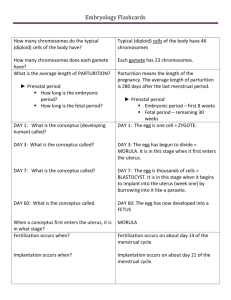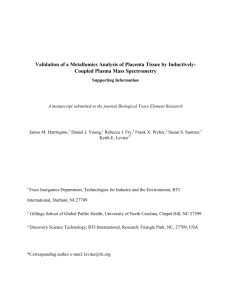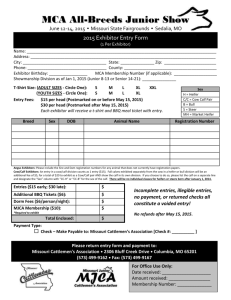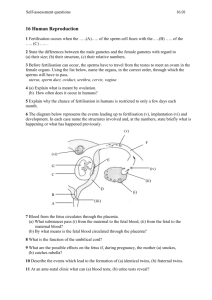Treating and preventing retained placenta in beef
advertisement
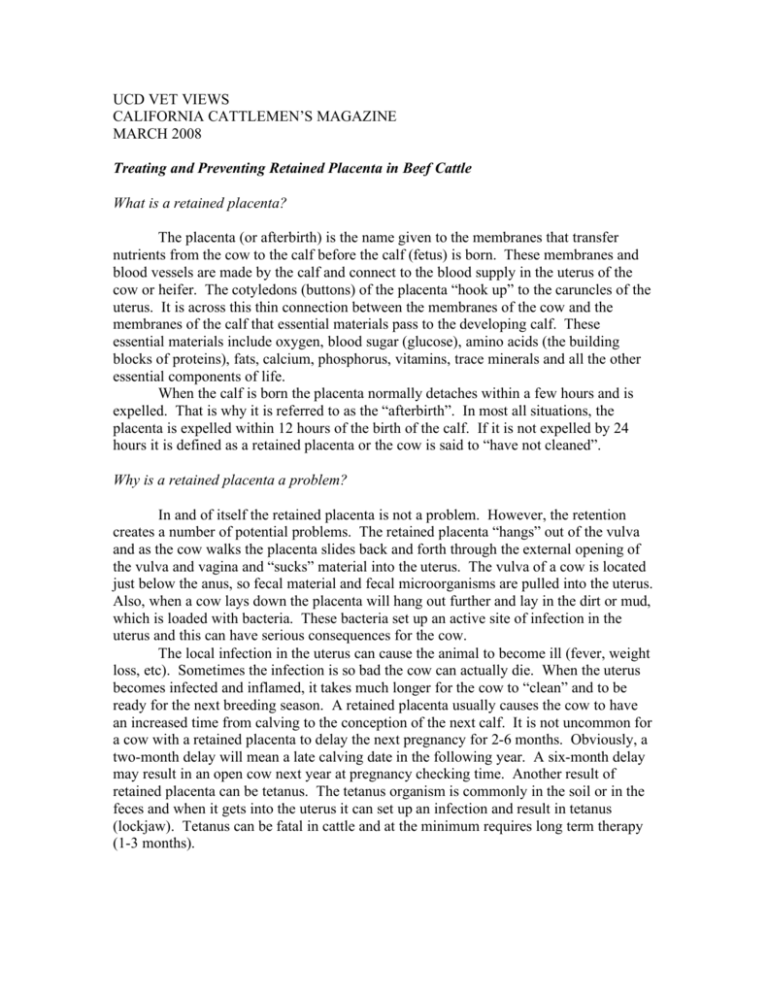
UCD VET VIEWS CALIFORNIA CATTLEMEN’S MAGAZINE MARCH 2008 Treating and Preventing Retained Placenta in Beef Cattle What is a retained placenta? The placenta (or afterbirth) is the name given to the membranes that transfer nutrients from the cow to the calf before the calf (fetus) is born. These membranes and blood vessels are made by the calf and connect to the blood supply in the uterus of the cow or heifer. The cotyledons (buttons) of the placenta “hook up” to the caruncles of the uterus. It is across this thin connection between the membranes of the cow and the membranes of the calf that essential materials pass to the developing calf. These essential materials include oxygen, blood sugar (glucose), amino acids (the building blocks of proteins), fats, calcium, phosphorus, vitamins, trace minerals and all the other essential components of life. When the calf is born the placenta normally detaches within a few hours and is expelled. That is why it is referred to as the “afterbirth”. In most all situations, the placenta is expelled within 12 hours of the birth of the calf. If it is not expelled by 24 hours it is defined as a retained placenta or the cow is said to “have not cleaned”. Why is a retained placenta a problem? In and of itself the retained placenta is not a problem. However, the retention creates a number of potential problems. The retained placenta “hangs” out of the vulva and as the cow walks the placenta slides back and forth through the external opening of the vulva and vagina and “sucks” material into the uterus. The vulva of a cow is located just below the anus, so fecal material and fecal microorganisms are pulled into the uterus. Also, when a cow lays down the placenta will hang out further and lay in the dirt or mud, which is loaded with bacteria. These bacteria set up an active site of infection in the uterus and this can have serious consequences for the cow. The local infection in the uterus can cause the animal to become ill (fever, weight loss, etc). Sometimes the infection is so bad the cow can actually die. When the uterus becomes infected and inflamed, it takes much longer for the cow to “clean” and to be ready for the next breeding season. A retained placenta usually causes the cow to have an increased time from calving to the conception of the next calf. It is not uncommon for a cow with a retained placenta to delay the next pregnancy for 2-6 months. Obviously, a two-month delay will mean a late calving date in the following year. A six-month delay may result in an open cow next year at pregnancy checking time. Another result of retained placenta can be tetanus. The tetanus organism is commonly in the soil or in the feces and when it gets into the uterus it can set up an infection and result in tetanus (lockjaw). Tetanus can be fatal in cattle and at the minimum requires long term therapy (1-3 months). What causes retained placenta? The list of potential causes is quite long; however, there are a number of common causes that affect beef cattle. It is easier to think about the causes in groups, so the following listing might be helpful. Mechanical Causes of Retained Placenta Difficult birth (calf too large for cow, backwards calf [breech birth], one leg or head backwards) Twins Cesarean section Fetal monsters or emphysematous fetus (gas-filled fetus) Nutritional Causes of Retained Placenta Energy or Protein Deficiency during pregnancy Vitamin A deficiency Selenium deficiency Iodine deficiency Vitamin E deficiency Management Causes of Retained Placenta Stress (Transportation or rough handling, poor feed conditions) Obesity Heredity Infectious diseases/Toxins Brucellosis Pine Needle abortion Leptospirosis IBR virus, BVD virus Foothill Abortion (EBA) How do I treat cows with retained placenta? If a cow has a retained placenta of 24-48 hours and is running a fever (rectal temperature over 102.5 degrees Fahrenheit) or is not eating it should receive attention and treatment. The minimum treatment would be an antibiotic such as a long-acting tetracycline (Biomycin®, LA-200®, Tetradure®, etc) and Lutalyse® (which can help to speed expulsion of the placenta). If the cow is depressed or dehydrated it will be necessary to have your veterinarian examine and treat the cow. They will probably flush the uterus as well as give you advice on other drugs to use over the next 5-7 days. Always seek your veterinarian’s advise on treating cows with retained placenta as the condition can deteriorate into a life-threatening one in a very short period of time. It is usually not necessary to manually remove the placenta; however, your veterinarian can advise you better after examining the animal. It is important to understand that there is no single course of treatment that will be safe and effective in every circumstance; thus your veterinarian’s advise will be crucial to success. Most of the drugs that are useful to treat a cow or heifer with retained placenta are not labeled for this condition. Therefore, these drugs are used in an EXTRALABEL manner and will REQUIRE one or more PRESCRIPTIONS from your veterinarian for this purpose. Also, there may be an extended withdrawal time for these drugs that will have to be adhered to. Additionally, if you have more than 1% of your cattle with retained placenta, you should seek professional help to prevent this problem. How can I prevent retained placenta problems? Since there are many causes of retained placenta, there is no simple answer. Some of the obvious answers include: (1) don’t allow cows to get too thin or too fat before calving, (2) reduce stress near calving as much as possible, (3) prevent exposure to pine needles, juniper trees, and pine trees (particularly Ponderosa Pines) before calving, (4) make sure your trace mineral and vitamin supplementation program is adequate, (5) prevent Foothill Abortion problems, and (6) maintain a sound vaccination program to minimize the chance of viral or bacterial abortions. Because calving problems often result in retained placenta, it is important to consider the appropriate selection of genetics for your herd as a part of prevention. One of the useful tools is birth weight EPD’s. Lower birth weights will decrease calving problems IF all other factors are equal. However, it is also important to remember that big cows with big pelvic canals can have big calves easily. So select bulls with birth weight EPD’s in keeping with your herd. Also, remember to look at the bull’s actual birth weight data and remember that the birth weight EPD numbers are not the same between breeds. One breed can have a bull calf with a birth weight of 100 pounds and a birth weight EPD of 1.0 while another breed can have a bull calf with a birth weight of 80 pounds and a birth weight EPD of 5.0. Obviously, the second bull will tend to have calves with lower birth weights IF all other factors are equal. Another tool available is pelvic measurements in yearling heifers. The value of this tool is to cull replacement heifers with small pelvic canals before breeding for the first time. Regarding birth weights, it is important to remember that the cow or heifer has 60% of the “input” into how large the calf is going to be. Therefore, genetic selection of the cowherd has more impact than the one time selection of the bulls. If you don’t have problems with retained placenta, that is excellent. If you do, there are a number of important items you will need to consider and discuss with your veterinarian. John Maas, DVM, MS Diplomate, ACVN & ACVIM Extension Veterinarian School of Veterinary Medicine, UC Davis

